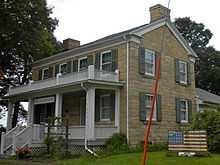Salem, Iowa
| Salem, Iowa | |
|---|---|
| City | |
 | |
 | |
| Coordinates: 40°51′11″N 91°37′15″W / 40.85306°N 91.62083°WCoordinates: 40°51′11″N 91°37′15″W / 40.85306°N 91.62083°W | |
| Country |
|
| State |
|
| County | Henry |
| Area[1] | |
| • Total | 0.61 sq mi (1.58 km2) |
| • Land | 0.61 sq mi (1.58 km2) |
| • Water | 0 sq mi (0 km2) |
| Elevation | 715 ft (218 m) |
| Population (2010)[2] | |
| • Total | 383 |
| • Estimate (2012[3]) | 382 |
| • Density | 627.9/sq mi (242.4/km2) |
| Time zone | Central (CST) (UTC-6) |
| • Summer (DST) | CDT (UTC-5) |
| ZIP code | 52649 |
| Area code(s) | 319 |
| FIPS code | 19-70230 |
| GNIS feature ID | 0461353 |
Salem is a city in Henry County, Iowa, United States. The population was 383 at the 2010 census.
History
Salem was laid out in 1839 by Aaron Street, Jr., and Peter Boyer.[4]
Geography
Salem is located at 40°51′11″N 91°37′15″W / 40.85306°N 91.62083°W (40.853073, -91.620845).[5]
According to the United States Census Bureau, the city has a total area of 0.61 square miles (1.58 km2), all of it land.[1]
Demographics
| Historical populations | ||
|---|---|---|
| Year | Pop. | ±% |
| 1880 | 524 | — |
| 1890 | 551 | +5.2% |
| 1900 | 548 | −0.5% |
| 1910 | 501 | −8.6% |
| 1920 | 494 | −1.4% |
| 1930 | 460 | −6.9% |
| 1940 | 457 | −0.7% |
| 1950 | 473 | +3.5% |
| 1960 | 442 | −6.6% |
| 1970 | 458 | +3.6% |
| 1980 | 463 | +1.1% |
| 1990 | 453 | −2.2% |
| 2000 | 464 | +2.4% |
| 2010 | 383 | −17.5% |
| Source:"American FactFinder". United States Census Bureau. and Iowa Data Center | ||
2010 census
As of the census[2] of 2010, there were 383 people, 176 households, and 105 families residing in the city. The population density was 627.9 inhabitants per square mile (242.4 /km2). There were 196 housing units at an average density of 321.3 per square mile (124.1 /km2). The racial makeup of the city was 97.1% White, 0.5% African American, 0.3% Native American, 0.8% Asian, and 1.3% from two or more races. Hispanic or Latino of any race were 2.6% of the population.
There were 176 households of which 23.9% had children under the age of 18 living with them, 40.9% were married couples living together, 13.6% had a female householder with no husband present, 5.1% had a male householder with no wife present, and 40.3% were non-families. 34.1% of all households were made up of individuals and 14.2% had someone living alone who was 65 years of age or older. The average household size was 2.18 and the average family size was 2.80.
The median age in the city was 44.6 years. 21.4% of residents were under the age of 18; 7.3% were between the ages of 18 and 24; 22.5% were from 25 to 44; 29.7% were from 45 to 64; and 19.1% were 65 years of age or older. The gender makeup of the city was 44.1% male and 55.9% female.
2000 census
As of the census[6] of 2000, there were 464 people, 202 households, and 124 families residing in the city. The population density was 763.7 people per square mile (293.7/km²). There were 213 housing units at an average density of 350.6 per square mile (134.8/km²). The racial makeup of the city was 97.41% White, 0.22% Native American, 0.43% Asian, 0.22% from other races, and 1.72% from two or more races. Hispanic or Latino of any race were 0.65% of the population.
There were 202 households out of which 29.7% had children under the age of 18 living with them, 48.5% were married couples living together, 7.4% had a female householder with no husband present, and 38.6% were non-families. 33.7% of all households were made up of individuals and 20.3% had someone living alone who was 65 years of age or older. The average household size was 2.30 and the average family size was 2.98.

In the city the population was spread out with 23.7% under the age of 18, 5.8% from 18 to 24, 27.6% from 25 to 44, 23.3% from 45 to 64, and 19.6% who were 65 years of age or older. The median age was 40 years. For every 100 females there were 91.7 males. For every 100 females age 18 and over, there were 97.8 males.
The median income for a household in the city was $31,500, and the median income for a family was $42,500. Males had a median income of $30,238 versus $22,143 for females. The per capita income for the city was $18,585. About 3.7% of families and 3.2% of the population were below the poverty line, including 4.6% of those under age 18 and 3.1% of those age 65 or over.
Notable people
- Lorenzo D. Lewelling, Governor of Kansas; born in Salem.[7]
- Thomas Poulter, Antarctic explorer and Geophyics scientist.
See also
- Holtkamp Round Barn, listed on the National Register of Historic Places
References
- ↑ 1.0 1.1 "US Gazetteer files 2010". United States Census Bureau. Retrieved 2012-05-11.
- ↑ 2.0 2.1 "American FactFinder". United States Census Bureau. Retrieved 2012-05-11.
- ↑ "Population Estimates". United States Census Bureau. Retrieved 2013-05-23.
- ↑ The History of Henry County, Iowa: Containing a History of the County, Its Cities, Towns, &c. Western Historical Company. 1879. p. 536.
- ↑ "US Gazetteer files: 2010, 2000, and 1990". United States Census Bureau. 2011-02-12. Retrieved 2011-04-23.
- ↑ "American FactFinder". United States Census Bureau. Retrieved 2008-01-31.
- ↑ "Kansas Governor Lorenzo Dow Lewelling". National Governors Association. Retrieved September 29, 2012.
| |||||||||||||||||